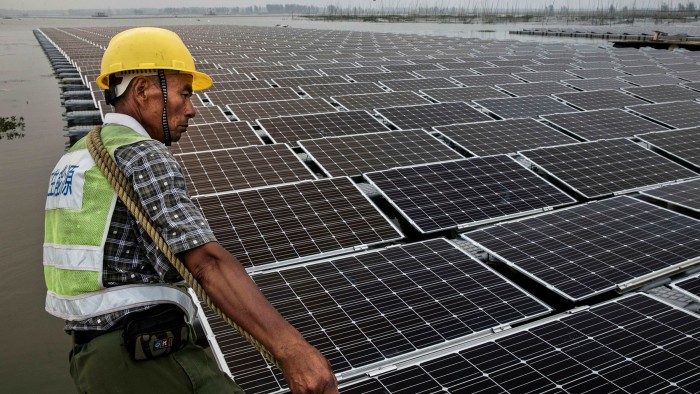China green energy ETFs deliver best performance in first half

Simply sign up to the Exchange traded funds myFT Digest -- delivered directly to your inbox.
Interested in ETFs?
Visit our ETF Hub for investor news and education, market updates and analysis and easy-to-use tools to help you select the right ETFs.
Green energy themed exchange traded funds in China have outperformed other thematic and broad-based ETF strategies in the first half of 2021, amid signs of a shift in the economy towards greener energy and more environmentally friendly consumer products.
ETFs investing in green energy have dominated the list of best-performing ETFs in China over the first six months of the year, with seven of the 10 ETFs being green energy themed products, Wind Info data show.
E Fund Management’s E Fund CSI New Energy ETF gained 45.5 per cent, leading the market, followed by China Asset Management’s ChinaAMC CSI New Energy ETF, which delivered 44.6 per cent in returns.
Penghua Fund Management’s Penghua CSI China Mainland Low Carbon Economy ETF, ranked third, recording a return of 42.5 per cent, and the Ping An CSI New Energy Car Industry ETF, followed with a 41.9 per cent return over the first six months of the year.

This article was previously published by Ignites Asia, a title owned by the FT Group.
Chinese president Xi Jinping has laid out targets for domestic carbon emissions in China to hit their highest point before 2030 before the country gradually transitions to a carbon-neutral economy by 2060.
Kevin Xu, partner, and mining and metals sector leader at Deloitte China, said most Chinese green energy ETFs focused on electric vehicles, batteries or solar energy.
“Against the backdrop of China’s 2030-2060 carbon targets, the electric power transportation and manufacturing sectors have been put under the spotlight and become the first movers to reduce carbon emission,” Xu said.
Kangting Ye, Singapore-based Asia senior analyst and China research practice lead at Cerulli Associates, said the rise of the green energy sector was being driven by both increasing domestic supply and demand.
Green energy materials exports could also benefit from overseas initiatives such as US president Joe Biden’s recent clean energy plan and the EU’s Green Deal (carbon border adjustment mechanism).
Ng Sze Yoon, Singapore-based senior director for Asia-Pacific insights at Broadridge, agreed that a clear, collective focus in China on tackling climate change was spurring growth in green energy ETFs.
“As part of national policy priorities, China set ambitious goals on carbon emissions to curb climate change risks. This represents a rapidly growing market for Chinese companies to actively engage in clean energy and energy conservation,” she said.
Asset managers, asset owners and investors would be likely to follow the Chinese government’s Climate Finance Guidance, and build their environmental, social and governance strategies around climate change mitigation, Ng added.
In October last year, five Chinese government ministries jointly issued the Climate Finance Guidance on promoting investment and financing to address climate change, aligning financial flows with the ecological and climate ambitions of China.
Climate Capital

Where climate change meets business, markets and politics. Explore the FT’s coverage here.
Are you curious about the FT’s environmental sustainability commitments? Find out more about our science-based targets here
Among the 925 China-domiciled ETFs in the market, more than 60 per cent reported positive performance, with about one-third posting negative returns.
China has seen about 205 ETF launches this year, with 18 of them technology themed, 11 green energy themed and 10 Star-market themed, according to data from Wind.
In trying to reach its carbon neutrality target, Chinese authorities are likely to push for green energy and electric vehicles to encourage more fund flows into ESG-related ETFs.
Cerulli’s Kangting said she expected the green energy ETFs in China to continue to perform well.
Broadridge’s Ng also agreed that green energy ETF performance would probably continue to be strong due to the regulatory push.
However, she said it was important to distinguish between the genuinely top-performing companies that were confirmed to have adopted new clean and green innovative strategies, and those that were simply riding the green wave.
Deloitte’s Xu said he expected a structural long-term growth story for China’s green energy sector.
For instance, China just announced a plan to install more than 30 gigawatts of green energy storage capacity by 2025, as part of efforts to boost renewable power consumption.
*Ignites Asia is a news service published by FT Specialist for professionals working in the asset management industry. It covers everything from new product launches to regulations and industry trends. Trials and subscriptions are available at ignitesasia.com.
Interested in ETFs?
Visit our ETF Hub for investor news and education, market updates and analysis and easy-to-use tools to help you select the right ETFs.

Comments